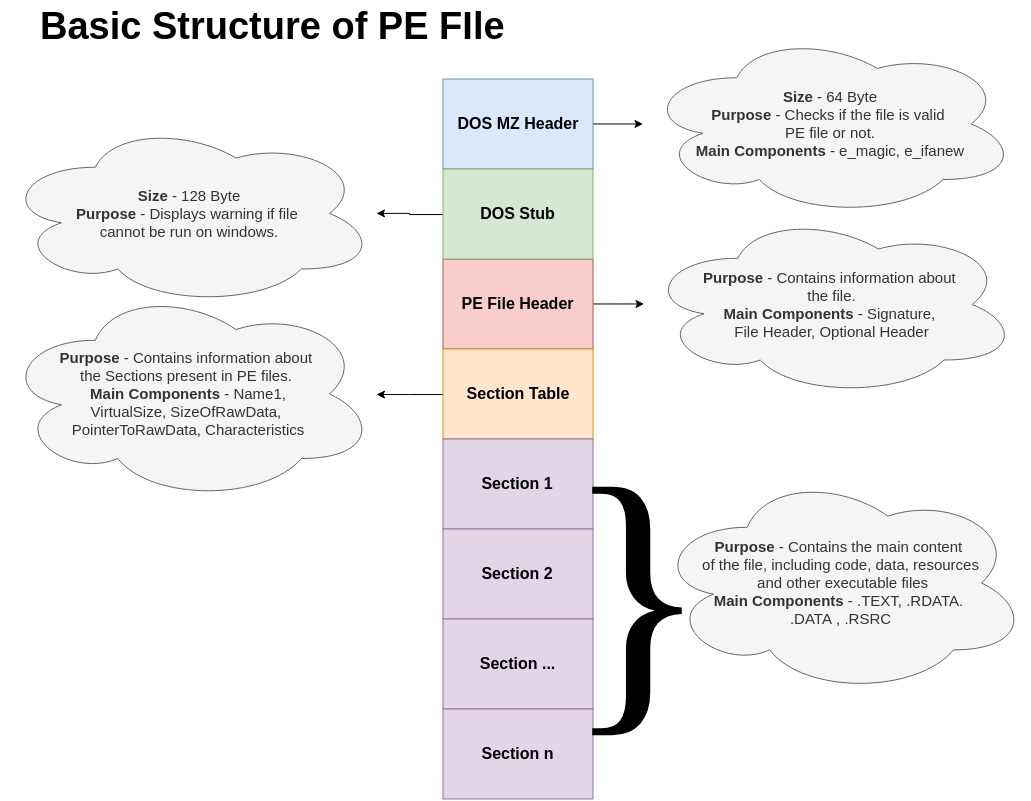Shellcode - Pt 2: Finding Exported Function
Now that we have the address of the module loaded into memory, we need to navigate its PE structure and locate the exported function. For this, we'll use LdrFuncAddr, which behaves similarly to GetProcAddress.
Retrieving Export Function
Here, since we already have the address of the module (DLL) loaded into the process, we need to navigate through its PE structure, passing through the PE headers and reaching the data directory, where we will find the IMAGE EXPORT DIRECTORY. For a better understanding of the PE format, check the link: PE Format - Microsoft Documentation.
I will demonstrate the structure using PE-Bear after loading the DLL, but in general, the format looks like this:
Lets go to the first header called IMAGE DOS HEADER, which has the following structure. From there, we’ll obtain the offset of the next header, known as the File Address of the new exe header, or e_lfanew.
This will take us to the IMAGE NT HEADERS where we have its signature PE00 equal to 504500 as I’ll show next.
Inside the IMAGE NT HEADERS, we have the IMAGE FILE HEADER and the IMAGE OPTIONAL HEADER. What interests us here is the IMAGE OPTIONAL HEADER, as it contains the data directories where we can find the IMAGE EXPORT DIRECTORY, which is what we are interested in.
Now, in the IMAGE OPTIONAL HEADER, we can see that the EXPORT DIRECTORY is the first data directory. We can proceed to this directory and find components important for building our function.
Here we can already see the exported functions. To access them, we need three important components:
- AddressOfFunctions: Specifies the address of an array of addresses of the exported functions.
- AddressOfNames: Specifies the address of an array of addresses of the names of the exported functions.
- AddressOfNameOrdinals: Specifies the address of an array of ordinal numbers for the exported functions.
Ordinals are used to identify the address of the function, not the name.
Steps for LdrFuncAddr
- Retrieve the address of IMAGE NT HEADERS using e_lfanew, which is the last Offset of IMAGE DOS HEADER.
- Access the IMAGE OPTIONAL HEADER within IMAGE NT HEADERS.
- Navigate to the data directory within IMAGE OPTIONAL HEADER, specifically to the first data directory which is the IMAGE EXPORT DIRECTORY, and retrieve its address.
- Access the components AddressOfNames, AddressOfFunctions, and AddressOfNameOrdinals.
- Perform a loop searching for the input, which is the name of the exported function.
LdrFuncAddr in ASM
1
2
3
4
5
6
7
8
9
10
11
12
13
14
15
16
17
18
19
20
21
22
23
24
25
26
27
28
29
30
31
32
33
34
35
36
37
38
39
40
41
42
43
44
45
46
47
48
49
50
51
52
53
54
55
56
57
58
59
60
section .text
global LdrFuncAddr
LdrFuncAddr:
; Receive parameters:
; [ebp+8] - Module base address
; [ebp+12] - Exported function name
; Save used registers
push ebp
mov ebp, esp
; Input parameters
mov edi, [ebp+8] ; Module base address
mov esi, [ebp+12] ; Exported function name
; Get IMAGE DOS HEADER
mov eax, [edi+0x3C] ; Offset to e_lfanew
add eax, edi ; Address of IMAGE NT HEADERS
; Get IMAGE OPTIONAL HEADER
add eax, 0x18 ; Offset to IMAGE OPTIONAL HEADER
mov ebx, [eax] ; Address of IMAGE OPTIONAL HEADER
; Get IMAGE EXPORT DIRECTORY
add ebx, 0x60 ; Offset to export directory
mov ecx, [ebx+0x1C] ; Address of export directory
add ecx, edi ; Absolute address of export directory
; Get necessary components
mov edx, [ecx+0x18] ; Address of AddressOfNames
add edx, edi ; Absolute address of AddressOfNames
mov esi, [ecx+0x1C] ; Address of AddressOfNameOrdinals
add esi, edi ; Absolute address of AddressOfNameOrdinals
mov edi, [ecx+0x20] ; Address of AddressOfFunctions
add edi, edi ; Absolute address of AddressOfFunctions
search_loop:
; Get the next name from the name list
mov eax, [edx]
add eax, edi ; Absolute address of function name
; Compare the current function name with the provided name
; If they match, find the address of the corresponding function
cmp byte [eax], 0
je not_found
mov ecx, esi ; Address of AddressOfNameOrdinals
mov eax, [ecx] ; Address of the function's ordinal
add eax, edi ; Absolute address of the function's ordinal
mov ebx, [edi+eax*4] ; Address of AddressOfFunctions
add ebx, edi ; Absolute address of AddressOfFunctions
mov eax, [ebx+eax*4] ; Address of the exported function
add eax, edi ; Absolute address of the exported function
ret
not_found:
; Move to the next name in the list
add edx, 4
add esi, 2
jmp search_loop
LdrFuncAddr in C
1
2
3
4
5
6
7
8
9
10
11
12
13
14
15
16
17
18
19
20
21
22
23
24
25
26
PVOID LdrFuncAddr( _In_ PVOID BaseModule, _In_ PCHAR FuncName){
PIMAGE_NT_HEADERS pImgNt = { 0 };
PIMAGE_EXPORT_DIRECTORY ExpDir = { 0 };
DWORD ExpDirSz = { 0 };
PDWORD AddrOfFuncs = { 0 };
PDWORD AddrOfNames = { 0 };
PWORD AddrOfOrdinals = { 0 };
PVOID FuncAddr = { 0 };
pImgNt = C_PTR( BaseModule + ((PIMAGE_DOS_HEADER)BaseModule)->e_lfanew);
ExpDir = C_PTR( BaseModule + pImgNt->OptionalHeader.DataDirectory[ IMAGE_DIRECTORY_ENTRY_EXPORT ].VirtualAddress );
ExpDirSz = U_PTR( BaseModule + pImgNt->OptionalHeader.DataDirectory[ IMAGE_DIRECTORY_ENTRY_EXPORT ].Size );
AddrOfNames = C_PTR( BaseModule + ExpDir->AddressOfNames );
AddrOfFuncs = C_PTR( BaseModule + ExpDir->AddressOfFunctions );
AddrOfOrdinals = C_PTR( BaseModule + ExpDir->AddressOfNameOrdinals );
for ( int i = 0; i < ExpDir->NumberOfNames; i++ ){
if ( StringCompareA( (PCHAR)BaseModule + AddrOfNames[ i ], FuncName ) == 0 ) {
return C_PTR( BaseModule + AddrOfFuncs[ AddrOfOrdinals[ i ] ] );
}
}
return NULL;
}




